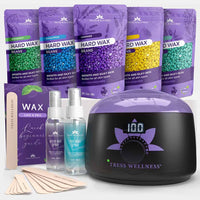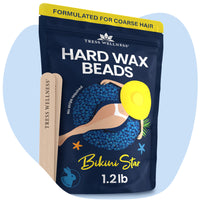Does waxing at home sound like a difficult task? Do you have a waxing kit but just can’t get started? Some nuggets of waxing wisdom from someone who has been doing it for 4 years might just help.
I am Keilah Bates, a licensed U.S.-based esthetician. I’ve helped develop products and provide advice for Tress Wellness to ensure the highest quality experience for waxing at home. With years of experience working with all skin types and assisting over 300 clients each month, I’ve learned what works best for a smooth, painless, and long-lasting wax. These expert waxing tips will guide you through the process, whether you’re new to waxing or a pro looking to fine-tune your technique.
1. Prep Your Skin Before Waxing
Proper skin preparation is the key to a successful and smooth waxing session. Start by exfoliating your skin 24 to 48 hours before waxing. This removes dead skin cells and allows the wax to grip the hair better. However, avoid exfoliating on the day of waxing, as this can make your skin more sensitive.
Cleanse the skin thoroughly just before waxing, but skip heavy moisturizers or oils. They can create a barrier, making it harder for the wax to adhere to the hair. Use a pre-wax spray designed to cleanse and prep the skin for the best results.
2. Choose the Right Wax for Your Skin Type
Using the right wax is essential for a smooth, irritation-free experience. For sensitive areas like the bikini line, I recommend hard wax. It adheres to the hair and not the skin, making it gentler for sensitive areas. Tress Wellness offers specially formulated hard wax beads for bikini waxing that are perfect for delicate skin but tough on coarse hair.
If you’re working on larger areas like legs or arms, soft wax is usually more effective. However, the type of wax should always match your skin's sensitivity level and the coarseness of your hair.
3. Wax in the Right Direction
Always apply wax in the direction of hair growth and remove it in the opposite direction. This technique minimizes the risk of breakage and ensures that hair is pulled from the root, giving you longer-lasting smoothness. Stretching the skin before pulling the wax helps reduce discomfort and gives cleaner results.
For areas like the bikini line, this step is particularly important. The hair tends to grow in different directions, so take time to observe the growth pattern for a smoother result.
Here's a tutorial on how to apply and remove wax:
@tresswellness_waxingkit #answer to @giuliahevi Our wax kit is for beginners and professionals alike, it has everything you need! #underarmwax #waxing #waxkit #waxpot #waxwarmer #waxkitathome #hardwax #waxbeads #howtowax #howtowaxlikeapro #waxtipsforbeginners ♬ original sound - Tress Wellness
4. Keep Your Wax at the Right Temperature
The temperature of your wax can make or break your waxing session. If it's too hot, you risk burning your skin; if it’s too cool, the wax won’t adhere properly to the hair. When using a wax warmer machine, aim for a honey-like consistency. Always test the temperature on a small patch of skin before applying to larger areas.
A good quality wax warmer machine, like the one in the Tress Wellness waxing kit, maintains the ideal wax consistency for an effective and comfortable waxing experience.
5. Don’t Wax Too Often
It’s important to allow your hair to grow to at least 1/4 inch before waxing. Waxing too frequently can result in irritation or uneven results. Hair needs to be long enough for the wax to grab it properly and remove it from the root. For most people, this means waxing every 3 to 4 weeks, depending on how fast your hair grows.
If you’re consistent with waxing, your hair will grow back thinner over time, making the process less painful and more effective.
6. Use Post-Wax Care Products
After waxing, your skin needs soothing care to reduce redness, prevent ingrown hairs, and speed up recovery. Aloe vera, chamomile, and tea tree oil are great ingredients for calming the skin after waxing. Tress Wellness’s post-wax spray is formulated with aloe and chamomile, which help hydrate and calm the skin, leaving it feeling refreshed.
You should avoid tight clothing and sweating immediately after waxing. Give your skin a chance to breathe and recover by wearing loose, breathable fabrics.
7. Exfoliate Between Waxing Sessions
Regular exfoliation between waxing sessions prevents ingrown hairs and keeps your skin smooth. Opt for a gentle exfoliant 2 to 3 times a week, especially in areas like the bikini line, where hair tends to grow thicker. However, avoid exfoliating for 48-72 hours after waxing to allow your skin to recover.
Using a body scrub or an exfoliating mitt works wonders to keep your skin fresh and free of buildup between sessions.
8. Stretch Your Skin While Waxing
One of the best tips for minimizing pain during waxing is to stretch the skin taut before removing the wax. This technique not only reduces discomfort but also ensures that the wax grabs the hair more effectively.
When waxing delicate areas like the bikini line, make sure you’re holding the skin tight in the opposite direction before pulling the wax strip off. It’s a simple trick that makes a big difference in your overall waxing experience.
9. Avoid Hot Showers and Sun Exposure After Waxing
Your skin will be more sensitive after waxing, so it’s important to avoid heat, steam, and sun exposure for at least 24 to 48 hours. Hot showers, saunas, or direct sunlight can cause irritation or even burns on freshly waxed skin.
If you’re waxing before a beach trip, plan your session a couple of days in advance to ensure your skin has enough time to heal.
10. Be Patient with Yourself
Waxing takes practice, especially if you’re doing it at home. Don’t rush the process. Set aside enough time to do it right, and remember that each session will get easier as you become more familiar with the techniques.
Using a quality waxing kit, like the Tress Wellness waxing kit, that includes all the tools you need — from wax beads to pre- and post-wax sprays — helps make your experience smooth, mess-free, and professional-grade.
Voila! These are my top 10 waxing tips to get the smoothest wax every time. They have worked wonders for me and my clients. Waxing doesn't have to be painful or complicated — it's all about finding what works best for your skin and hair type. Hope this helps!




